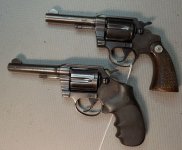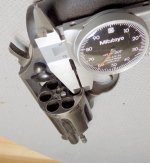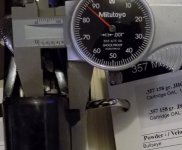I am guessing there is a ~1% variation in loads for varying the bullet, and reading a ~38% variation in loads due to load book variation.
1992 Lyman's 47 th 16.0 gr AA#9 158 gr JSP 1719 fps 10 contender
2000 Accurate Arms 13.0 gr AA#9 158 gr XTP 1261 fps 6" revolver
2001 Accurate Arms 15.0 gr AA#9 158 gr XTP 1633 fps 6" revolver
1999 Midway load m 11.7 gr AA#9 158 gr XTP 1365 fps 10" test barrel 35,000 psi
What happens when I try to verify?
CAUTION: The following post includes loading data beyond or not covered by currently published maximums for this cartridge. USE AT YOUR OWN RISK. Neither the writer, The Firing Line, nor the staff of TFL assume any liability for any damage or injury resulting from use of this information.
I got (5) Colt Police Positive 38 specials from AIM surplus in May 2001 for $80 each for destructive test. They were police surplus made in 1965.
I reamed the chambers in one cylinder longer by 0.15" so I could put 357 mag brass in it. And I cut 1" off the frame so I could put on Cobra size gripper grips.
≥ 2001 Clark[me] 17.0 gr AA#9 158 gr XTP 4" revolver threshold of sticky cases
With me in the mix the 38% load book to load book variation turns into 45% variation.
What causes the case(s) to get sticky?
https://groups.google.com/forum/?hl=en&fromgroups#!msg/rec.guns/S_dalM1NJe0/cBSU4bR2jz8J
Thin chamber walls and wimpy fingertip extraction for 6 cylinders at a time.
The originally 38 special revolver tested above has 0.060" thick chamber walls.
In contrast, my 1954 Colt 357 magnum dual tone has chamber walls 0.099" thick and would take a higher load to get sticky.
Further still, a thicker wall chamber 357 mag single shot rifle with leveraged extraction would take an even higher load to get sticky.



